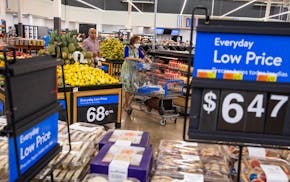In a state that exports more than a third of its agricultural production, it's not enough to only watch the local weather: Rain patterns in Panama matter, too, as does the occasional shower of missiles in the Red Sea.
Those global shipping bottlenecks have turned to chokepoints, driving up the cost to ship U.S. grain around the world and putting American farmers at a disadvantage while competitors reap record harvests.
"We're seeing a cluster of events that really is requiring shipping to respond in a way it hasn't had to previously," said James Spear, a shipping expert at SUNY Maritime College, adding rerouting — at great expense — is now commonplace.
Years of drought have led to restrictions on the all-important Panama Canal, a vital passageway for Asia-bound cargo shipped from the Gulf of Mexico, including soybeans grown in Minnesota.
"Having competitive access to that market is so critically important," said Justin Cauley, senior director of transportation at CHS. "The Panama Canal is a shortcut, saving time, fuel and labor costs. The remaining restrictions are not allowing us to run the biggest possible grain ships through there."
While Panama Canal traffic is edging back toward normal as the drought recedes, another valuable shortcut on the other side of the world remains fraught.
"There are a lot of companies avoiding the Suez Canal, and CHS is one of them," Cauley said.
The link between the Mediterranean and the Indian Ocean has seen a substantial drop in traffic due to Houthi — a Yemeni Islamic fundamentalist group — attacks on commercial ships in response to Israel's war in Gaza.
All told, global shipping is facing delays and increased costs unseen since the days of pandemic supply chain meltdowns. It takes weeks longer and costs 30% more to ship to Asia around the southern tip of Africa instead of through the Panama Canal when departing the Gulf of Mexico, where grain flows from across the Mississippi River basin.
Inver Grove Heights-based CHS charters about 350 vessels a year to carry grain and fertilizer to far-flung destinations. About a third of those ships typically use the Panama Canal, while 10% relied on the Suez Canal last year.
The backlog at the Panama Canal meant CHS was often unable to run the biggest ships through the locks this year, which meant shipping less at a time.
"Because of the demand to move other products through the canal, our biggest grain ships are typically moved through canal slots that are being auctioned off to other cargoes," Cauley said. "Urgency and auction price doesn't translate to grain movements."
In some cases, he said, the company can reroute grain to ship out of Pacific Northwest ports, but that might not pencil out for all growing regions.
Minnetonka-based Cargill has 700 vessels chartered at any given time, meanwhile, a third of which are built to traverse the Panama Canal. Few of the ag trader's chartered ships routinely traverse the Suez Canal, and it is rerouting some.
Cargill-chartered ships have twice suffered damage in the Black Sea amid the Russia-Ukraine war in recent years.
The canal crises and higher shipping costs come as commodity prices fall toward a four-year low, hitting both agribusinesses in the bottom line. U.S. ag exports are also expected to continue falling this year amid heightened competition around the world.
Minnesota farms, ranches and dairies produced $26 billion worth of goods last year, exporting $10 billion of that, according to state data. Minnesota grain exports dropped 24%, however.
Spear said the worst is likely passed for the Panama Canal, which should return to full traffic in the next several months. The Suez Canal will likely only see ship owners, charterers and insurance companies willing to risk attacks for the foreseeable future.
"It's a hell of a job to get the right ship at the right location at the right time and still be positioned for another delivery to another part of the world," he said. "There can be pinch points."
Minnesota's med spa industry rises in popularity — and with little regulation

Ramstad: Readers say Walmart won't be paying the ultimate price of Trump's tariffs

How Minnesota businesses can spot and prevent invoice fraud
No place for cryptocurrency in retirement portfolios
